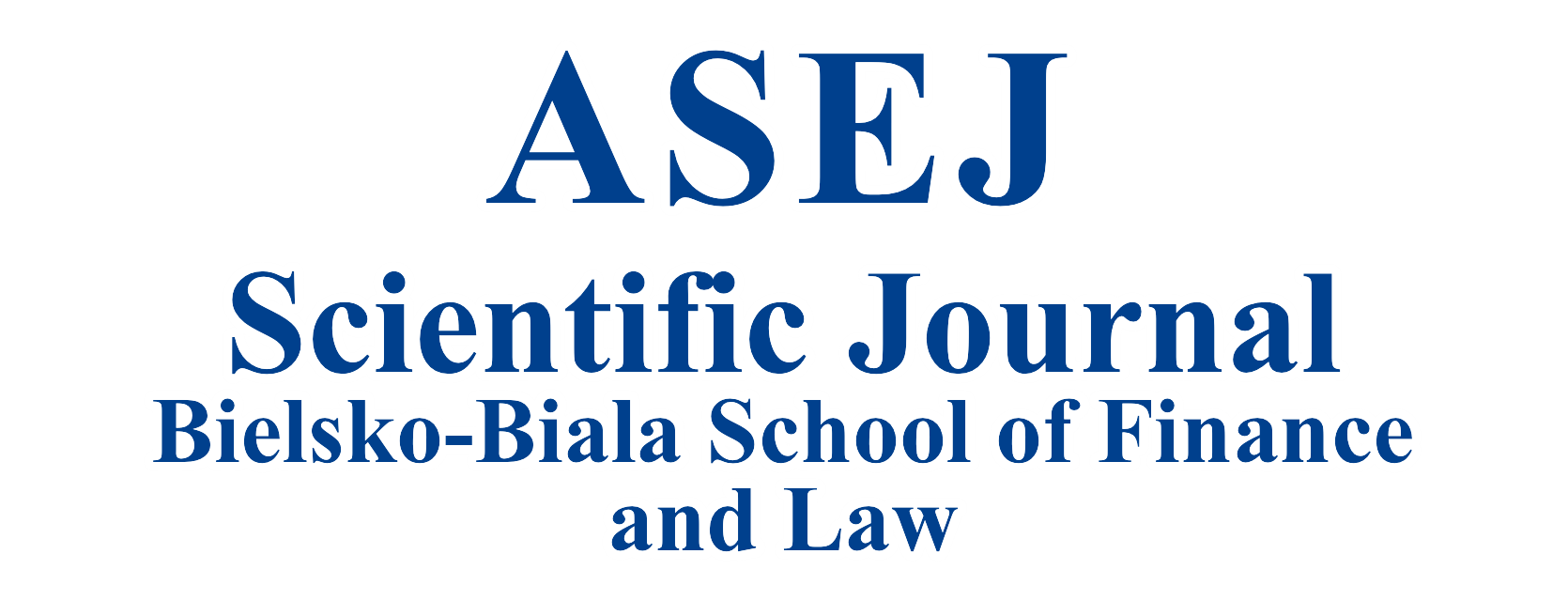Abstrakt
Against the backdrop of a turbulent environment and changing economic, social, and technological realities, public sector organizations are facing the challenge of improving the effectiveness of their operations.
The concept of New Public Management (NPM), drawing from private sector solutions, has significantly contributed to the reorganization of public administration through workforce reduction, decentralization, and privatization, with a focus on performance management.
Academic literature continues to seek answers regarding the internal and external conditions for measuring effectiveness in public institutions, including higher education institutions.
A particularly important role in the public sector is played by Business Environment Institutions (BEIs) – non-profit entities that bridge the gap between market mechanisms and public administration activities, becoming partners in the achievement of public goals.
This article aims to identify and critically assess models for measuring the effectiveness of public organizations that can be adapted to evaluate the performance of public Business Environment Institutions. The analysis is based on theoretical perspectives, such as structural contingency theory and new institutional organization theory, in order to explain both the diversity and the tendency towards isomorphism in the institutions under consideration
Bibliografia
Bogt, H. J., Jan Van Helden, G., & van der Kolk, B. 2015. Challenging the NPM ideas about performance management: Selectivity and differentiation in outcome-oriented performance budgeting. Financial Accountability & Management, 31(3), 287–315. https://doi.org/10.1111/faam.12058
Boyne, G. A. 2002. Concepts and Indicators of Local Authority Performance: An Evaluation of the Statutory Frameworks in England and Wales. Public Money & Management 22: 17–24.
Boyne, G.A., Meier, K.J., O’Toole Jr., L.J., & Walker, R.M.. 2006. Public Service Performance. Perspectives on Measurement and Management. Cambridge: Cambridge University Press.
Carmona, S., Grönlund, A. 2003. Measures vs. actions: The balanced scorecard in Swedish law enforcement. International Journal of Operations & Production Management 23, 1475–96.
Donaldson, L. (2001). The contingency theory of organizations. Sage Publication Inc. London.
Eliuz, S., Kapucu, N., Ustun, Y. & Demirhan, C. 2017. Predictors of an Effective Performance Measurement System: Evidence from Municipal Governments in Turkey. International Journal of Public Administration, 40 (4), 329–341http://dx.doi.org/10.1080/01900692.2015.1113547
Febriyanti, D., Widianingsih, I., Sumaryana, A., & Buchari, Rd. A. 2024. The typology and determinant of performance measurement for public sector organizations – a literature review. Cogent Business & Management, 11(1). https://doi.org/10.1080/23311975.2024.2315681
Franco‐Santos, M., Kennerley, M., Micheli, P., Martinez, V., Mason, S., Marr, B., Gray, D., Neely, A. 2007.Towards a definition of a business performance measurement system. International Journal of Operations & Production Management 27 (8), 784-801
Frączkiewicz-Wronka, A. 2010. Pomiar efektywności organizacji jako obszar konwergencji metod, narzędzi i instrumentów zarządzania między sektorami biznesowym a publicznym. Organizacja i Zarządzanie: kwartalnik naukowy, 4 (12), 5-24.
Gasparski, W. 2004. Normy etyczne a normy sprawnościowe w zarządzaniu, biznesie i gospodarce, [w:] Kieżun W. (red): Krytyczna teoria organizacji. Wybór zagadnień. Wydawnictwo Wyższej Szkoły Przedsiębiorczości i Zarządzania. Warszawa 2004, s. 35-57.
Gębczyńska, A., Brajer-Marczak, R. 2020. Review of Selected Performance Measurement Models Used in Public Administration. Administrative Sciences, 10(4), 99. https://doi.org/10.3390/admsci10040099
Gródek-Szostak Z. 2017. Zróżnicowanie definiowania instytucji otoczenia biznesu w regionalnych programach operacyjnych na lata 2014-2020 [W:] Kaczmarek J. & Krzemiński P. (red.), Doskonalenie działania przedsiębiorstw i instytucji wobec przemian społeczno-gospodarczych: innowacje - finanse - otoczenie biznesu (s. 233-243),Fundacja Uniwersytetu Ekonomicznego.
Gródek-Szostak Z., Kapuścińska J., Kołodziej J. & Kotnis K. (2020). Otoczenie instytucjonalne przedsiębiorczości w regionie : studium przypadku województwa małopolskiego [W:] Jaki A. & Nesterak J. (red.), Wiedza, gospodarka, społeczeństwo : innowacje i rachunkowość na drodze cyfrowej transformacji gospodarki (pp. 145-161)Towarzystwo Naukowe Organizacji i Kierownictwa. Dom Organizatora.
Gródek-Szostak Z. 2023. Upowszechnianie transferu technologii w sieci innowacji. (Seria: Zarządzanie). Wydawnictwo C.H. Beck.
Gruening, G. 2001. Origin and theoretical basis of new public management. International Public Management Journal, 4 (1), 1-25, https://doi.org/10.1016/S1096-7494(01)00041-1.
Hansen, S.C., Van der Stede, W.A. 2004. Multiple facets of budgeting: an exploratory analysis. Management Accounting Research 15 (4), 415-439. https://doi.org/10.1016/j.mar.2004.08.001.
Henri, J. F. (2006). Organizational Culture and Performance Measurement Systems. Accounting, Organizations and Society, 31, 77-103.
https://doi.org/10.1016/j.aos.2004.10.003
Hood, C. 1991. A public management for all seasons? Public Administration, 69(1), 3–19.
Hudson, M., Smart, A., Bourne, M. 2001. Theory and practice in SME performance measurement systems”, International Journal of Operations and Production Management, 21 (8), 1096-1115
Kaplan, R.S., Norton, D.P. (1992), The balanced scorecard: measures that drive performance, Harvard Business Review, 70 (1), 71-79.
Kinyuira, Daniel, and Jomo Kenyatta. 2019. Using results chain framework as a tool for the improvement of performance evaluation in firms. Journal of Strategy & Performance Management 7, 28–36.
Khomba J.K. 2015. Conceptualisation of the Balanced Scorecard (BSC) model: A critical review on its validity in Africa. International Journal of Commerce and Management 25 (4), 424–441.
Leung, L.C., Lam, K.C., Cao, D. 2006. Implementing the balanced scorecard using the analytic hierarchy process & the analytic network process. Journal of the Operational Research Society, 57 (6), 682-691.
Melkers, J. (2006). On the road to improved performance. Public Performance & Management Review, 30(1), 73-95.
Midwinter, A. 1994. Developing Performance Indicators for Local Government: The Scottish Experience. Public Money & Management 14, 37–43.
Norreklit, H., Jacobsen, M., Mitchell, F. 2008. Pitfalls of using the balanced scorecard”, Journal of Corporate Accounting & Finance, 19 (6), 65-68.
Petticrew, M., Roberts, H. 2006. Systematic Reviews in the Social Sciences: A Practical Guide. Wiley, London.
Poister, T.H., Streib, G.D. 1999. Strategic Management in the Public Sector: Concepts, Models, and Processes. Public Productivity & Management Review, Vol. 22 (3), 308-325
Pollitt, Ch., Bouckaert, G. 2011. Public Management Reform: A Comparative Analysis. Oxford: Oxford University Press.
Powell, W.W; Bromley, P. 2015. New Institutionalism in the Analysis of Complex Organizations. International Encyclopedia of the Social & Behavioral Sciences (Second Edition), 764-769 https://doi.org/10.1016/B978-0-08-097086-8.32181-X
Puhakka, M. 2018. Performance Management in a Public Sector Organisation: Creating KPIs for a PSC Web Portal. https://www.theseus.fi/bitstream/handle/10024/150978/Puhakka_Merja.pdf?sequence=1&isAllowed=y
Pyszka A. 2015. Istota efektywności. Definicje i wymiary, Studia Ekonomiczne, 230,13-25.
Rainey, H. G., & Jung, C. S. (2015). A conceptual framework for analysis of goal ambiguity in public organizations. Journal of Public Administration Research and Theory, 25(1), 71–99. https://doi.org/10.1093/jopart/muu040
Simons, R. 1990. The role of management control systems in creating competitive advantage: new perspectives. Accounting, Organizations and Society, 15, 127-143
Steccolini, I. 2019. Accounting and the post-new public management: Re-considering publicness in accounting research. Accounting, Auditing & Accountability Journal, 32 (1), 255-279
Stenberg, C.W., Brunback, G.B., McFee, T.S. 1982. From MBO to MBR. Public Administration Review 42(4), 363-371.
van Dooren,W., Bouckaert,G., Halligan, J. 2015.Performance Management in the Public Sector. Routledge, London.
van Helden, G.J., Reichard, C. 2013. A meta-review of public sector performance management research. Tékhne - Review of Applied Management Studies, 11 (1), 10-20. https://doi.org/10.1016/j.tekhne.2013.03.001
Wodecka-Hyjek A. 2023. Koncepcja oceny przedsiębiorczości publicznej w urzędach administracji samorządowej, (Seria Specjalna: Monografie nr 275), Wydawnictwo Uniwersytetu Ekonomicznego w Krakowie, Kraków.
Yuan, J., Zeng, A.Y., Skibniewski, M.J., Li, Q. 2009. Selection of performance objectives and key performance indicators in public-private partnership projects to achieve value for money. Construction Management and Economics 27, 253–70.

Utwór dostępny jest na licencji Creative Commons Uznanie autorstwa – Użycie niekomercyjne 4.0 Międzynarodowe.
Prawa autorskie (c) 2025 Zofia Gródek-Szostak, Henryk Gurgul, Nina Dubiel

